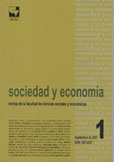Una aproximación econométrica a la tasa de retorno social de la educación
Keywords:
educación, economía de la educación, tasas de retorno de la educación, tasa de retorno privada, tasa de retorno social, externalidades, externalidades pecuniarias, capital humano.Main Article Content
The measurement of rates of return to education for groups of individuals from the National Household Survey of Colombia (ENH) yields higher estimates of social returns than individual returns. By modelling simultaneously the individual within his/her group and the determinants at the aggregate level, it is found that the gap between these returns is explained by externalities. The income premium
explained by being part of a group depends on the concentration of human capital in the same group and it explains the higher social return. This finding is in contradiction to previous research that has found the social rate of return to less than the private rate. An immediate implication of our results is a change in economic policies aimed at translating resources from professional education in public institutions to primary education.
Downloads

This work is licensed under a Creative Commons Attribution-NonCommercial 4.0 International License.
Revista sociedad y economía editada por la Facultad de Ciencias Sociales y Económicas de la Universidad del Valle se encuentra bajo una Licencia Internacional Creative Commons Atribución - No comercial 4.0
Basada en una obra en http://sociedadyeconomia.univalle.edu.co

